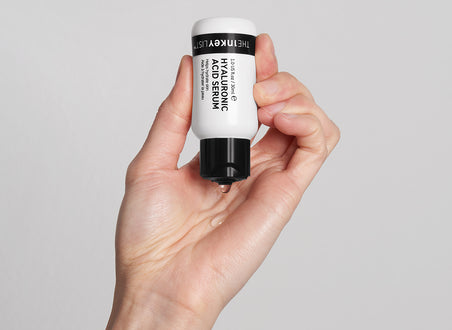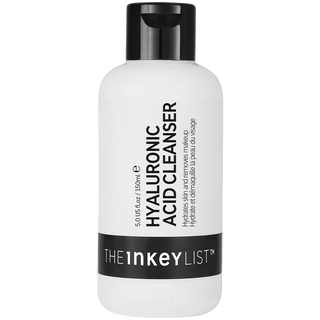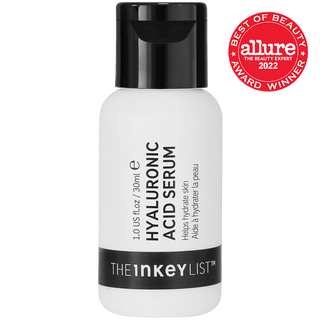We discussed.. Hyaluronic Acid Serum

At the INKEY List, we say Hyaluronic Acid Serum is a must have ingredient because it is the foundation hydration ingredient. If your skin is hydrated, it can effectively absorb more products you layer on top and have a bigger impact on the skin. We are here to discuss the pros and cons, as well as assessing if it all it’s cracked up to be, with INKEY co-founder Mark Curry, digital creator Nadine Baggott (@nadinebaggott) and Dr Adeline Kikam (@brownskinderm). Here’s everything you need to know…
What is Hyaluronic Acid and what is it for?
Dr Kikam: Hyaluronic Acid is a humectant. Humectants are hydroscopic ingredients that bind water to collagen and help to plump and hydrate the skin. We as human beings have natural Hyaluronic Acid; most of it is found in skin but it’s also found in our eyes, joints, tendons, ligaments. As we get older, we lose this Hyaluronic Acid in skin so we need products to help boost our reserves up and keep our skin bouncy and looking youthful.
Can you have too much Hyaluronic Acid?
Dr Kikam: I feel like it’s how you use it vs the amount. If you are piling on Hyaluronic Acid Serum and then you are not using a moisturiser or an occlusive agent to seal in all that water in the surface of the skin, then it’s just going to make you skin drier by losing that hydration to evaporation. Evaporation in turn causes more dryness and dehydrated skin. The different molecular weights of the Hyaluronic Acid does matter as well so knowing the type of formula you are using also makes a difference because we want a combination of smaller and larger molecule weight.
Mark: I agree, it’s all about how you use it, not how much. A humectant is a substance that almost acts as a magnet of water so its draws water in. You need to lock in that moisture on the skin barrier and have a moisturiser on top so you don’t risk drying the skin out.
Nadine: One of my followers said that Hyaluronic Acid Serum makes their skin dry, and I tend to agree but the problem occurs when you are using it on its own and you’re not locking it in. Some of the original Hyaluronic Acid Serum formulas about 10 years ago tended to be singular molecular and they were quite drying, making skin feel tight. But if you think of the ‘slip’ of modern formulas like the INKEY list Hyaluronic Acid Serum you can feel that its multi molecular, which is what you should be looking for.
Apart from it being a hero hydrating agent, what are the other benefits of Hyaluronic Acid?
Dr Kikam: Hyaluronic Acid has anti-inflammatory benefits and wound repair. I love it because I am a big fan of Vitamic C which helps with free radical damage and Hyaluronic Acid also does this.
Should you approach Hyaluronic Acid depending on your skin type?
Dr Kikam: A recent study did find that higher molecular weight Hyaluronic Acid is more anti-inflammatory than the lower molecular weight which is actually inflammatory – so what does that mean for you? If you have sensitive skin you really want to be particular about using lower molecular weight because when you have sensitive skin your more likely to get irritated or get inflammation and you don’t want to risk that.
If you have dry or dehydrated skin you want to make sure you’re getting both large and small weight molecular formulas so you don’t get lots of the higher weight just sitting on top of your skin and pulling all the moisture to the top and that getting evaporated, leaving your skin even more dehydrated. You want to have that balance of higher and lower; the lower weight will draw the moisture deep into the epidermis and the higher molecular weight acts as a film on top.
Hyaluronic Acid Serum is also wonderful for oily skin because you already have that oil there that would assist and balance with the Hyaluronic Acid. Hyaluronic Acid is all about hydration, and we are focusing on the outermost layer of the skin and what is going to help retain that moisture. If you already have oily skin, we need that balance of water and hydration so we can have perfectly plump, nicely hydrated skin.
What is the difference between Hyaluronic Acid Serum and other hydrating ingredients like Glycerin and PGA?
Mark: Glycerin is much smaller and it can penetrate right through, but it’s less inflammatory and facilitates more reinforcement of the skin barrier. Glycerin is a really underrated product, actually.
Polyglutamic Acid is a much bigger molecule (almost a super size Hyaluronic Acid) and it sits on top of the skin and supports hydration on the top layer but what it’s actually doing is informing the skin to create more of its own Hyaluronic Acid, which is why you get that double bump when you use them together in your skincare routine.
Dr Kikam: Yes, Polyglutamic Acid has that higher molecular weight and therefore sits on the top most layer of the epidermis vs Hyaluronic Acid Serum, where we can have that top down effect and deeper penetration.
Are the percentages of Hyaluronic Acid important? Is there a key % people should be looking for?
Dr Kikam: I think most studies are saying 1% for the least irritation, but if you have sensitive skin, you may want to stay even lower.
Mark: There are a lot of studies that say if you go beyond 4%, a higher concentration, there is slightly less water and there is more risk of drying out. The optimum is 1-2% as we currently understand from the studies that have been conducted.
When should you apply Hyaluronic Acid Serum?
Nadine: I have always followed the rule of thinnest formula to thickest formula with oils and SPF last, but I use Hyaluronic Acid Serum after cleansing on damp skin. In the AM, I then use Vitamin C straight away and at night I use Retinol Serum. I like the feeling of having slightly slippery skin after Hyaluronic Acid Serum, as I feel it allows everything else to go on more easily. I also love how it never clashes with any other active ingredient. It’s the heart of my skincare routine in terms of hydration. I have also found the older I have got, the more my skin has needed Hyaluronic Acid and the more I have relied on it.
Mark: We at the INKEY List say you should use our Hyaluronic Acid Serum immediately after cleansing and while your skin is still damp to get the most out of it; it primes your skin for whatever else you will put on it too.
Dr Kikam: Hyaluronic Acid Serum is great for prepping your skin to receive all of the other active ingredients in your routine and making them more effective. So, if you have been using Hyaluronic Acid Serum as your last step you might want to flip that and make sure it’s at the beginning.
When it comes to Retinol, we know it can be really irritating depending on the formula, so prepping the skin with Hyaluronic Acid Serum can be beneficial. If you are somebody with well-balanced skin but easily irritated, you can apply Hyaluronic Acid Serum, then Retinol Serum and then Hyaluronic Acid Serum again afterwards, followed by a moisturiser.
Is there anywhere on your face that your shouldn’t use Hyaluronic Acid Serum?
Dr Kikam: It is going to depend on the formulation. I would recommend going by the brand guidelines on the bottle, so if they say don’t put this around or near eyes then I would suggest following that. There may be some other ingredient in the formula that is not suitable for that area.
Nadine: I would use the INKEY List Hyaluronic Acid Serum up and around my eyes as it’s a great prep for using concealer.
Can you use Hyaluronic Acid on your hair?
Dr Kikam: You can use Hyaluronic Acid in hair; when you apply to the hair shaft, it’s going to draw that moisture to the hair cuticle. However, it can actually make the hair drier when you overdo it as it can sometimes pull the water out of the cuticle. I would only use Hyaluronic Acid that has been formulated especially for the hair for this reason.
Mark: I agree, to get best results it’s preferable to use a product formulated for hair, therefore you are guaranteed it’s doing what it should be doing. Our Hyaluronic Acid Hair Treatment is deliberately ionic and has a different blend of Hyaluronic Acid weights. Because it’s ionic, it’s going to cling to the cuticle and coat it; that coating boosts the appearance and shine.
Does Hyaluronic Acid have anti-ageing benefits?
Dr Kikam: Yes it does. It binds to collagen when we have the lower molecular weight, and goes deeper into the dermis. When you start to develop fine lines and wrinkles, you are losing collagen and elasticity, so when you use Hyaluronic Acid you plump the skin and it appears more bouncy and helps to flatten out those fine lines and wrinkles.
Mark: It is temporary though, right? It’s giving that instant lift rather than working long term. That’s why we recommend Retinol more for anti-ageing as when you start to use Retinol consistently, you trigger skin renewal and cell turnover rate. That’s why I would actually say that Hyaluronic Acid isn’t an anti-ageing active in that sense.
Dr Kikam: But remember, it has anti-inflammatory benefits and the reason we want to prevent free radical damage is because free radicals break down collagen and elastin. So in that sense it is.
Is there a different amount, type or grade of Hyaluronic Acid that is needed for more melanated skin?
Dr Kikam: No there isn’t. Hyaluronic Acid is Hyaluronic Acid when it comes to different skin types and tones.
Why do some Hyaluronic Acid Serum's ‘pil’ on the skin?
Mark: That won’t be the Hyaluronic Acid but the formulation itself.
Nadine: I feel people always blame their makeup, SPF or other active ingredient but I agree it’s always the film formula.
Mark: They are formulated in a way where actually the specific ingredients are designed to stay right on the top of the skin and they intermesh and lock. This locking can be great for oily skin or those who have dry patches as a film formula can act as a primer before SPF or makeup etc. If you have a moisturiser with Hyaluronic Acid that you would apply as your last step before makeup, manufacturers might want to put a film formula in it to give a nice feel, but in the process they don’t test it for when people are going to apply makeup on top, and therefore that’s when piling occurs.
Shop The INKEY List's Hyaluronic Acid Serum.











